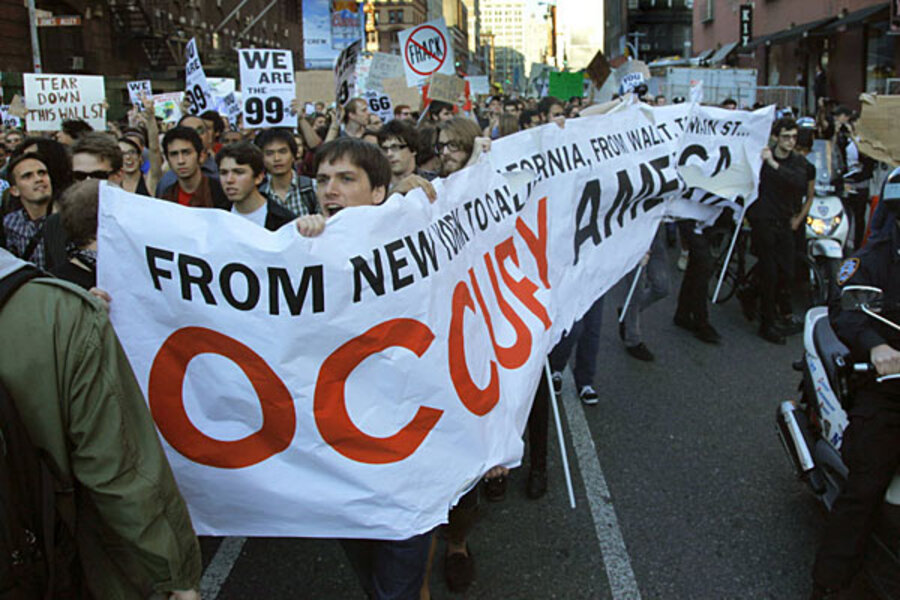'Occupy Wall Street': If protesters don't list demands, will they get anything?
Loading...
| Los Angeles
On the eve of a huge solidarity rally planned Thursday for Freedom Plaza in Washington, and with new recruits emerging daily across the nation, the emphatically diverse “Occupy” protest movement is already facing a Shakespearean-level dilemma: To be or not to be specific about its demands.
If it refuses to spell out actionable agendas, will it get anything at all? Ay, there’s the rub.
“Occupy Wall Street” has listed virtually every progressive concern of the early 21st century in its current manifesto – from environmental degradation and corporate greed to animal rights and gender, race, and age equality, as well as collective bargaining rights. Now a new item has emerged, listing access to higher education as a basic human right, perhaps not surprising considering the youthful face of the movement.
Such idealism is all well and good for a protest moment, but not enough for a genuine movement, says Professor Ted Morgan of Lehigh University in Pennsylvania, author of “What Really Happened to the 1960s: How Mass Media Failed American Democracy.”
“For this to move from a colorful, attention-grabbing protest, they are going to have to reach into communities, connect with workplaces, churches, schools,” he says. “That’s how you build organizations that create change.
“It takes a long time, and it’s not as exciting or dramatic as camping out in front of City Hall,” he adds with a laugh, “but that’s how grassroots change happens.”
The team behind “Occupy Los Angeles” is finding its own way. They just have their own way of going about it. Taking a page from the Wall Street playbook, the dozens of Angelenos hunkered down Wednesday in the first big rain of the season say they meet every night at 7:30 on the steps of City Hall.
“Everyone is welcome,” says Lisa Clapier, who directs media for the group from a small tent with tables filled with laptops, coffee makers, donated donuts, coolers, and a small generator. But, she adds, “They have to come as an individual. They may not come as a group with their own agenda.”
She notes that a local activist ensemble tried to press its concerns on the group at the Tuesday night meeting. “We kicked them out as a group,” she says, adding, “but let them know they were welcome to voice their individual issues any time.”
As unions and other traditionally Democratic groups have joined marches and expressed support for the Occupy movement, many original members have shared their concern that the movement will be co-opted by these organizations with strong political ties.
“We’re happy to have them be in solidarity with us,” says Ms. Clapier, “but we don’t want to be tied to their positions.”
Interviews with those at the “Occupy Los Angeles” encampment outside City Hall – the 300 or so people who spend the nights here pitch their tents on the sidewalk to comply with “don’t sleep on the grass” ordinances – show most participants feel this movement is just beginning and getting more structured every day.
Whereas a march by members of New York’s “Occupy Wall Street” to the Brooklyn Bridge last Saturday resulted in hundreds of arrests, this encampment is peaceful and trying to work with city officials.
The group assembles every night at 7:30 on the steps nearby and holds a general council. Joe Briones, a 27-year-old film major at nearby LA City College, lives at the site and still attends classes via subway.
“We feel we are working hand-in-glove with the city here,” says Mr. Briones. He explained how volunteers Googled the term, “general assembly formats” and have copied one used in Spain.
“This is direct democracy,” he says. “People propose ideas and if the group doesn’t like it, it gets thrown out.”
Mayor Antonio Villaraigosa visited Wednesday after a City Council hearing that was streamed live on websites, with council-invited speakers stepping up to the mike for a minute each, distilling what each thinks the council can do to meet the group’s list of broad goals.
“Four city council members came out and talked to us yesterday and shook our hands and told us they are in solidarity with our goals,” says Clapier, who acknowledges that at the moment the goals are focused on the big picture. She says the group is whittling down a list of some 50 goals to 12 by next week.
Margot Paez, a director, writer, and actor, is attending the encampment as both a protester and a journalist for insightoutnews.org.
“I am watching these developments from the inside and am really struck by how the mainstream media has tried to write this off as a bunch of hippies,” she says. “I consider it my contribution to help correct that misconception.”
The challenge for many protest movements as they try to evolve is that “building more formal organizations will necessarily exclude some participants and issues,” says Marc Dixon, assistant sociology professor at Dartmouth College in New Hampshire.
It is important to recognize that the protesters have succeeded in one significant way already by bringing some of these issues to the public, he says, “be it economic inequality, the undue influence of Wall Street, or enlivening the democratic process.”
Bringing attention to neglected issues is one thing protest movements do well, he notes. But they run the risk of not putting forth a more explicit program or demands while media and public attention is greatest.
“As media attention wanes, their leverage with policymakers also declines and the potential for significant political change diminishes,” he points out. “It is hard to imagine a more opportune time than now.”





